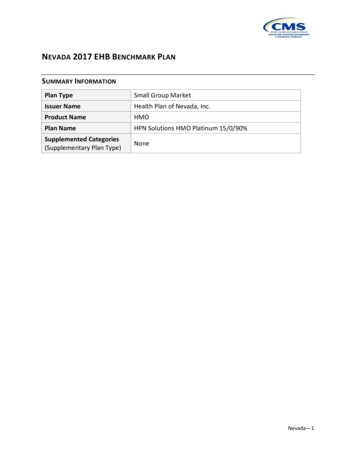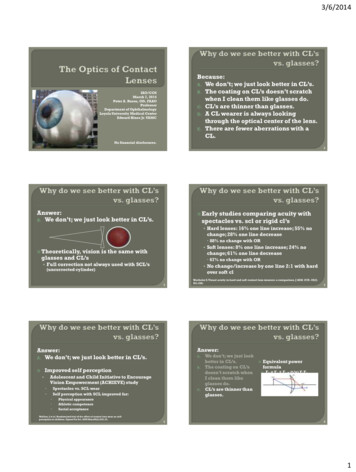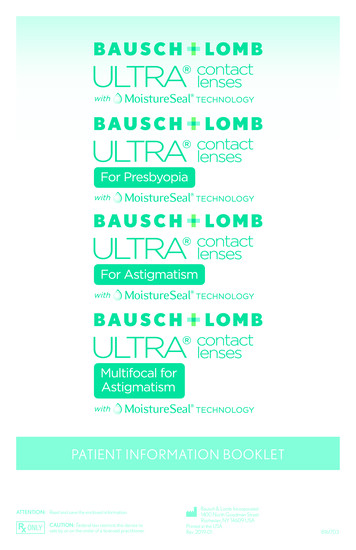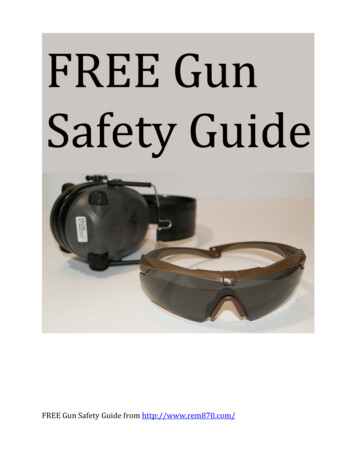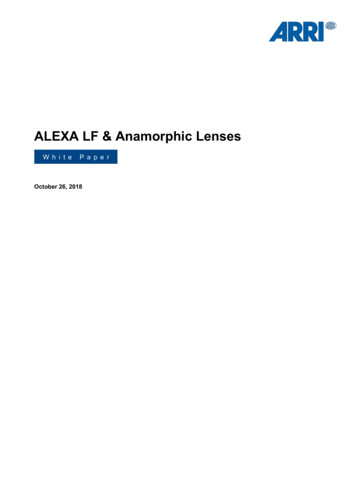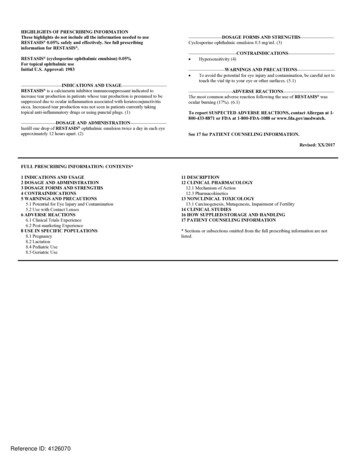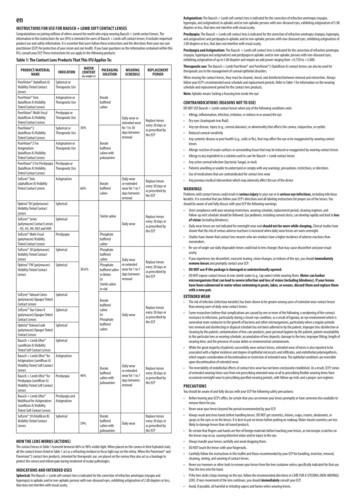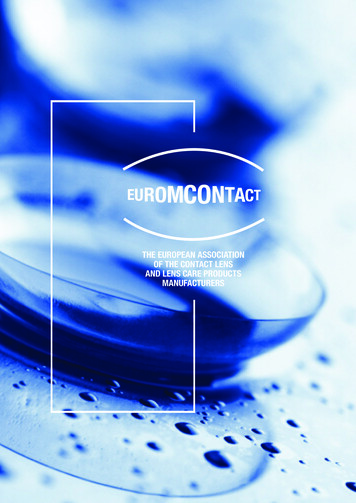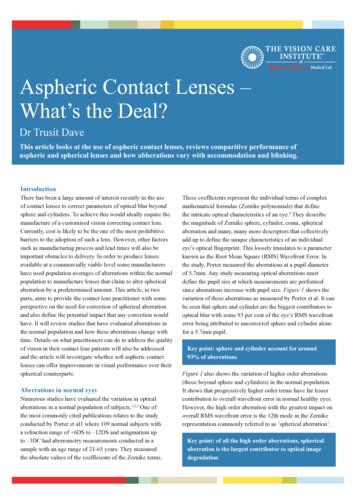
Transcription
Aspheric Contact Lenses –What’s the Deal?Dr Trusit DaveThis article looks at the use of aspheric contact lenses, reviews comparitive performance ofaspheric and spherical lenses and how abberations vary with accommodation and blinking.IntroductionThere has been a large amount of interest recently in the useof contact lenses to correct parameters of optical blur beyondsphere and cylinders. To achieve this would ideally require themanufacture of a customised vision correcting contact lens.Currently, cost is likely to be the one of the most prohibitivebarriers to the adoption of such a lens. However, other factorssuch as manufacturing process and lead times will also beimportant obstacles to delivery. In order to produce lensesavailable at a commercially viable level some manufacturershave used population averages of aberrations within the normalpopulation to manufacture lenses that claim to alter sphericalaberration by a predetermined amount. This article, in twoparts, aims to provide the contact lens practitioner with someperspective on the need for correction of spherical aberrationand also define the potential impact that any correction wouldhave. It will review studies that have evaluated aberrations inthe normal population and how these aberrations change withtime. Details on what practitioners can do to address the qualityof vision in their contact lens patients will also be addressedand the article will investigate whether soft aspheric contactlenses can offer improvements in visual performance over theirspherical counterparts.Aberrations in normal eyesNumerous studies have evaluated the variation in opticalaberrations in a normal population of subjects.1,2,3 One ofthe most commonly cited publications relates to the studyconducted by Porter et al1 where 109 normal subjects witha refraction range of 6DS to –12DS and astigmatism upto –3DC had aberrometry measurements conducted in asample with an age range of 21-65 years. They measuredthe absolute values of the coefficients of the Zernike terms.These coefficients represent the individual terms of complexmathematical formulae (Zernike polynomials) that definethe intricate optical characteristics of an eye.4 They describethe magnitude of Zernike sphere, cylinder, coma, sphericalaberration and many, many more descriptors that collectivelyadd up to define the unique characteristics of an individualeye’s optical fingerprint. This loosely translates to a parameterknown as the Root Mean Square (RMS) Wavefront Error. Inthe study, Porter measured the aberrations at a pupil diameterof 5.7mm. Any study measuring optical aberrations mustdefine the pupil size at which measurements are performedsince aberrations increase with pupil size. Figure 1 shows thevariation of these aberrations as measured by Porter et al. It canbe seen that sphere and cylinder are the biggest contributors tooptical blur with some 93 per cent of the eye’s RMS wavefronterror being attributed to uncorrected sphere and cylinder alonefor a 5.7mm pupil.Key point: sphere and cylinder account for around93% of aberrationsFigure 1 also shows the variation of higher order aberrations(those beyond sphere and cylinders) in the normal population.It shows that progressively higher order terms have far lessercontribution to overall wavefront error in normal healthy eyes.However, the high order aberration with the greatest impact onoverall RMS wavefront error is the 12th mode in the Zernikerepresentation commonly referred to as ‘spherical aberration’.Key point: of all the high order aberrations, sphericalaberration is the largest contributor to optical imagedegradation
Mean Absolute Zernike Coefficient (microns)Figure 1: Distribution of mean absolute wavefronterror for each Zernike term (up to 5th order).4Sphere &cylinder3.5It may therefore be argued that the next parameter that contactlenses should correct (after spherical and cylindrical correction)should be spherical aberration. In making this argument,one must consider that spherical aberration in a population(although generally positive) is variable and follows a normaldistribution with its peak at approximately 0.1 0.1µm witha 6mm pupil.2,5,6 As eye-care professionals we are moreaccustomed to understanding the effect of blur in dioptric termsas this is the primary measure of defocus in routine refraction.As a rough guide, 0.1µm of RMS Zernike spherical aberrationwould represent only around 0.12DS at a 6mm pupil!SA32.521.510.5Key point: the average spherical aberration in normaleyes equates to around 0.12D spherical defocus034567891011 12 13141516 17 181920Ansi Zernike ValueZernike terms 3-5 in ANSI units represent spherical and cylindrical components,Zernike term 12 is the Zernike representation of spherical aberration. After Porter et al1Key point: accurate correction of sphere AND cylinderare very important before considering correction of highorder aberrations of the eyePorter et al also evaluated the average amount of high orderaberration in the normal population. Figure 2 shows that inthe 109 subjects evaluated, mean high order aberration wasclose to zero for all components except for Zernike sphericalaberration. In any individual subject, high order aberrationsvary significantly, but average out to zero across a population;however spherical aberration is the high order aberrationthat is consistently biased to a positive value across a normalpopulation.Key point: in a normal population, spherical aberrationis positive and has a value of 0.1 0.1µm for a 6mm pupil2,5,6Mean Zernike Coefficient (microns)Figure 2: Zernike terms averaged across 109subjects in Porter et al’s study10.250.2Spherical 2131415Ansi Zernike Number161718192021For an in-depth explanation of Zernike polynomials theauthor would highly recommend an excellent review ofZernike polynomials and wavefront aberration in an article byCharman.7Cornea and crystalline lens counterbalanceMany scientific studies have demonstrated that the cornea is aflattening ellipse. Its shape progressively flattens out towardthe periphery (Figure 3). This shape drastically reduces thelevel of positive spherical aberration of the cornea comparedto the spherically shaped cornea. Nevertheless, the sphericalaberration of the cornea is still positive.8 However, the sphericalaberration of the whole eye is less than the spherical aberrationof the cornea alone. This implies that the crystalline lensmay have a role in the partial correction of corneal sphericalaberration.Figure 3: Cornea flattening towards periphery
Research by Artal9 and co-workers investigated the relationshipbetween the cornea and crystalline lens. They found thatfor their sample of 57 myopes and 16 hyperopes evidenceto support that there are compensatory aberrations in thecrystalline lens that effectively reduce the aberration induced bythe cornea.Key point: the cornea and lens interact to reduce overallaberration of the eyeSpherical aberration and its correctionSpherical aberration typically occurs with spherical surfaces,rays which are parallel to the optical axis but at differentdistances from the optic axis fail to converge to the same point(Figure 4). This results in a diffuse circular blur around pointsources.Figure 4: Simulated ray-trace of a lens exhibitingspherical aberration.Marginal rays are over-refracted compared to paraxial raysresulting in ‘positive’ spherical aberration.For a single lens, spherical aberration can be minimized byaltering lens form. By changing the curvature of the surfacesusing aspheric curves, compensation of the refractive effect inthe periphery of the lens can be optimized.Over the years two approaches have been taken bymanufacturers with respect to the correction of sphericalaberration in contact lenses.Approach 1The first is to address spherical aberration in high-poweredspherical soft contact lenses. Therefore produce a contact lenswith an aspheric front surface that minimizes the inducedspherical aberration of the contact lens power (for example,Frequency 55 Aspheric from Coopervision).Approach 2The second is to address the correction of spherical aberrationof the contact lens and the mean spherical aberration of the eye(for example, PureVision from Bausch & Lomb).There are a number of aspheric contact lens designs claimingto provide enhanced acuity over their spherical counterparts.Before evaluating published data on studies comparing asphericand spherical contact lenses on subjects’ eyes, let’s considerwhat happens to the spherical aberration of a spherical softcontact lens when it is placed on an eye.Spherical soft lenses on real eyes – what happens?Spherical soft contact lenses induce spherical aberration in AIR.If the lens is of positive power, it induces positive sphericalaberration, conversely, if it is negative, it induces negativespherical aberration. This would be true if soft sphericalcontact lenses were measured in air. However, when softspherical lenses are placed on aspheric corneae, they adopt theaspheric shape of the cornea. Cox10 has shown that as a resultof the flexure effects of soft lenses, the effect of lens-inducedspherical aberration is negligible for lens powers between 3.00and -6.00 for pupil diameters of 6mm. It is worth noting thatthe reference pupil size is 6mm; during photopic and possiblymesopic conditions, most patients will have pupil sizes lessthan 6mm, hence the effect of spherical aberration would benegligible in an even wider range of lens powers. Asphericoptics would be useful in high plus powers, particularly inaphakes, but for the majority of spherical prescriptions with6mm pupils, Cox’s study shows that an aspheric front surfacemakes little difference to the induced spherical aberration ofspherical soft contact lenses. Therefore, do we need to considercorrecting spherical aberration of the normal healthy eye?The optical performance of spherical and asphericsoft contact lensesOver recent years soft lenses have been available in asphericdesigns and these are claimed to minimize aberrations and improvevisual performance. A recent study by Lindskoog Petterson et al11evaluated the effect of Zernike spherical aberration with differentcommercially available contact lenses with and without aberrationcontrol. They compared the spherical aberration of the unaidedeye, eyes fitted with a spherical hydrogel daliy disposable contactlens (CIBA Focus Dailies ) and also a lens designed to correctaberrations (Definition AC Everyday , Optical Connection).Comparison of the two lens wearing groups showed a statisticallysignificant difference in spherical aberration between the wearersof the two contact lenses. Surprisingly, there was less residualspherical aberration with the spherical lens than the aberrationcontrolling lens. In fact, the aberration-controlling lens inducedsignificantly more negative spherical aberration.
Another aspect of their study compared the change in measuredspherical aberration with an aspheric silicone hydrogel lens(PureVision , Bausch and Lomb, designed to reduce sphericalaberration of the lens and eye combined) to the sphericalaberration of the eye without a contact lens. Their resultsshowed that the lens designed to control spherical aberrationover-corrected spherical aberration, resulting in a shift tomean negative spherical aberration. PureVision is claimed toshift spherical aberration by 0.15µm (for 6mm pupils). In theLindskoog Petterson study, spherical aberration was correctedby an average of 0.19µm for 6mm pupils. It is interesting to notethat in their group, all subjects were myopic and thus the effectsof lens flexure could possibly have induced an over-correctionof spherical aberration. The authors recommend that it maybe prudent to measure the aberrations of the patients wearingsuch contact lenses to assess their effect on an individual basis,although this may not be feasible in clinical practice sinceaberrometers are not routinely available.In another study by Efron et al,12 spherical and aspheric contactlenses (Biomedics 55 and Biomedics 55 Evolution ,Coopervision) were compared in terms of Zernike sphericalaberration and high and low contrast visual acuity. No significantdifferences were found between the spherical and aspheric lensdesigns in 10 subjects who were wearing -2DS and -5DS lenses inboth mesopic and photopic conditions. Aberration measurementswere scaled down to the smallest pupil size in the sample groupas pupillary dilation was not performed. Comparisons of Zernikeaberration were therefore made at pupil sizes of 3.2mm for the-2DS lens in photopic conditions and 3.8mm for mesopic. Forthe -5DS lens wearers measurements were scaled down to pupilsizes of 3.3mm for photopic and 4.7mm for mesopic conditions.Although this will not show the impact of aberration at thecommonly cited 6mm pupil size it does represent the level ofaberration encountered in a ‘real’ life scenario, and highlights thatwith these lenses, fitting an aspheric lens design did not lead toan improvement in visual acuity, aberration control nor subjectiveperformance when compared to an equivalent soft lens design.These results confirm the work of Cox10 who stated that for pupilsizes up to 6mm there would be no noticeable benefit in sphericalaberration correction for prescriptions of 3 to -6DS in normalhealthy eyes.Key point: clinical studies confirm theoreticalcalculations. The correction of spherical aberration innormal healthy eyes with aspheric lenses provides nosignificant reduction in spherical aberration (for sphericalprescriptions between 3 and -6DS). Aspheric lenses maybe of benefit for high hyperopes.One should also consider that the discussions thus far have onlyconsidered the emerging aberrations at the plane of the pupilarising from a point focus centred at the fovea. The effect ofvision quality at the periphery (namely outside the fovea) is notconsidered in any of the above discussions.Performance of aspheric contact lenses for the correction oflow levels of astigmatismPractitioners sometimes cite the correction of low astigmatismas a reason for prescribing aspheric contact lenses. Morganet al investigated the visual performance of an aspheric softcontact lens (Frequency Aspheric, Coopervision) with thatof a soft toric contact lens (SofLens 66 Toric, Bausch &Lomb) and spectacle correction in a group of low astigmtas(cylinders of 0.75 or 1.00 DC). For small pupil sizes there waslittle difference in high and low contrast visual acuity withthe three different refractive correction options, although forlarger pupils, visual performance was significantly better withthe toric soft contact lenses and spectacles compared to theaspheric contact lenses (by half-line or more).Changes in spherical aberration with accommodationand ageThus far we have shown that over a normal population the corneainduces the highest levels of aberrations but overall, individualhigher order aberrations are virtually zero for the eye – all thatis except for spherical aberration, which is consistently positive(mean 0.1µ). What would be the advantage of the eye havingresidual positive spherical aberration and what is the impact ofaccommodation on spherical aberration of the eye?The key impact of positive spherical aberration when viewinga distant object would be increased depth of focus. The impactof an aberration free eye when viewing distant objects would bepin-point clear vision (for distant objects), but there would begreater blur of all objects at closer distances. Positive sphericalaberration (as well as small pupils) increases the depth of field ofthe eye thus the perceived blur of near objects whilst looking inthe distance would be subtly reduced. Therefore, there is somelogic as to why the eye has a mean residual positive sphericalaberration of 0.1µm.Those practitioners who may disagree with the above statementand present the benefits of clearer distance vision facilitatedby correcting mean population spherical aberration in contactlenses (or other modalities) may wish to consider the impact ofaccommodation and age on spherical aberration. Studies haveshown that aberrations change in complex ways with increasingaccommodation, for most observers the spherical aberration ofthe eye decreases, on average becoming zero with around 3 - 4
dioptres of accommodation.14-16 There are two points to considerhere. Firstly, correcting spherical aberration in a phakic patientwill only provide a correction for one distance. When thepatient accommodates, there will again be residual sphericalaberration that will now be negative (as accommodationinduces negative spherical aberration). Secondly, if oneconsiders that positive spherical aberration during near focusreduces the depth of field (distant objects appear to be moreblurred) then the fact that during accommodation the crystallinelens increases its negative spherical aberration to render theeye with little or no overall spherical aberration is a remarkableexample of the optical robustness of the eye.Another reason why it may not be viable to correct sphericalaberration in a normal population comes to light whenevaluating the variation of spherical aberration over differentage ranges. Fujikado et al17 showed the high order aberrationsincrease with age primarily as a result of changes to thecrystalline lens. Specifically with regard to age and sphericalaberration, there is an increase in positive spherical aberrationwith age. Again, this represents an optical advantage as oneprogressively moves towards presbyopia. Indeed, manymultifocal contact lenses and intraocular lenses exploit theadvantages of positive spherical aberration in an attempt tocorrect distance and near sight.Key point: spherical aberration of the eye is not static.Accommodation induces relative negative sphericalaberration. Typically, spherical aberration is reducedduring accommodation.Temporary variation in high order aberrationsThe eye is a biological tissue and the effects of tears andblinking have an effect on the measurement and variationof ocular aberrations. Tear break-up induces significantaberrations to the eye (Figure 5). Koh et al18 showed that thereis a 44% increase in high order aberrations pre break-up to posttear break-up in the eyes of 20 normal subjects.In another, particularly interesting study, Koh et al19 measuredthe high order aberrations of 15 non contact lens wearers and15 symptomatic contact lens wearers (subjects complained ofdryness, blurring, fluctuating vision and the use of lubricants).Sequential measurements of high order aberrations wereperformed using an aberrometer every second for 60 secondswith subjects instructed to blink every 10 seconds. Bothgroups of subjects had aberrometry measurements on twooccasions wearing two hydrogel daily disposable lenses,1 DAY ACUVUE and 1 DAY ACUVUE MOIST (Johnson& Johnson Vision Care). The key difference between theselenses is the inclusion of PVP internal wetting agent intothe matrix of the etafilcon A material in the Moist product.Koh et al18 demonstrated that high order aberrations werestatistically significantly less with 1 DAY ACUVUE MOIST in the symptomatic group of wearers. Furthermore, convertingaberrometry data into two other metrics (the Fluctuation Index(FI) and the Stability Index (SI)), they found that both noncontact lens wearers and symptomatic contact lens wearersexhibited less variation in these values with 1 DAY ACUVUE MOIST compared to with 1 DAY ACUVUE (Table 1). Inessence this means that the incorporation of PVP into the lensreduces vision variability.In our non-daily disposable contact lens wearing patients therealso is the significant issue of lens deposition, which will furtherreduce tear break up time. Practitioners, therefore, would bewell advised to pay attention to patients’ symptoms of vision andto the pre-lens tear film quality. Routine aftercare questioningon the quality of vision after insertion, end of day and end ofwearing cycle will alert the practitioner to vision quality issues.Typically, changing the lens more frequently or to a lens withbetter wettability (such as the inclusion of internal wetting agentsin the lens material) will often improve the quality of vision inaddition to aiding patient symptoms of discomfort and dryness.Key point: Tear film stability plays an important rolein vision quality. Poor tear film stability increases highorder aberrations by 44%. Contact lenses with PVPincorporated in the lens matrix have been shown tohave less high order aberrations.Figure 5: Tear break-up. The dark areas show areaswhere tears are not wetting the cornea.
Table 1: Key results from Koh et al19 study on high order aberrations in contact lens wearersNon contact lens wearing groupSymptomatic contact lens wearersTotal high order aberrations (RMS, µm)1 DAY ACUVUE 1 DAY ACUVUE Moist P-value (paired t-test)0.163 0.0650.144 0.0500.1090.242 0.1570.140 0.0370.013 (significant)FI (fluctuation index)1 DAY ACUVUE 1 DAY ACUVUE Moist P-value (paired t-test)0.031 0.0340.021 0.0280.018 (significant)0.087 0.1040.018 0.0100.014 (significant)SI (stability index)1 DAY ACUVUE 1 DAY ACUVUE Moist P-value (paired t-test)0.005 0.0090.002 0.0050.0620.024 0.0340.002 0.0030.019 (significant)How to improve visual performance in soft contact lens wearersAs practitioners, our role is to provide consistently clear vision forour contact lens patients. This article has described how currentaspheric soft lenses are designed to minimize aberrations andimprove visual performance for an “average” individual. However,differences between patients including ocular shape, pupil size,refraction, accommodation and tear film, mean there are varyingdegrees of aberrations. Hence a specific average design may notimprove vision performance for those who are not “average”, andmay even make it worse for some. The research to date shows thatlenses to control spherical aberration appear to have limited use toimprove the visual performance for the majority of our contact lenswearers although there may be some benefits for those with higherprescriptions or with large pupils.Additional steps can be taken to ensure patients are managedappropriately from a vision quality standpoint (Table 2).Table 2 – additional steps to maximise vision quality in soft contact lens wearers1. Accurately correct sphere and cylindera. Fit low astigmats with soft toric lenses2. For high refractive errors, spherical aberration can play a role in visual blur, in particular in those with larger pupilsizes. Note that at present, lenses designed to correct spherical aberration have not been shown to give superior visualperformance than conventional spherical lenses.3. Consider factors such as lens movement, centration and rotation that can play a significant role in vision quality, inparticular with higher prescriptions4. Investigate patient symptoms with respect to vision qualitya. Include detailed questioning such as ‘how do you rate the quality of your vision’ (ratings are very useful here).b. I nvestigate ‘when’ e.g. at end of day, when working on PC, last few days before lenses need replacing and so on5. Evaluate lid margins and tear film (including pre-lens tear break-up time). High order aberrations are greatlyaffected by poor quality tears.6. Evaluate lens deposition – this leads to optical blur and an increase in high order aberrations; many patientscomment on the improvement in vision post blink.7. Consider the following management options:a. If acuity is reduced before lens replacement, move to a more frequent replacement such as a daily disposable.b. If deposits are related to material e.g. high lipid deposition with a silicone hydrogel, move to another material or daily disposable orenhanced solution. The recent introduction of a silicone hydrogel daily disposable will address deposition whilst maintaining high oxygentransmissibility. The above action would be taken in association with appropriate lid management in the presence of meibomian glanddysfunction related lipid deposition.c. Select a highly wettable lens material. Recent research shows lenses with embedded PVP in the material reduce high order aberrations,particularly in symptomatic dry eye patients.
SummaryNumerous studies have shown that the average sphericalaberration of the eye is around 0.1µm. This approximates toa small degree of optical blur in units of dioptres. Sphericalaberration becomes more important when correcting highrefractive errors, particularly hypermetropia due to theincreased level of positive spherical aberration in the correctingcontact lens. Typically, spherical aberration will play a modestrole in optical clarity for prescriptions greater than 3DS and-6DS for 6mm pupils. However in cases where pupil sizes aresmaller this range will be even narrower. Aspheric optics usedin contact lenses in order to reduce higher order aberrations todate are unlikely to provide vision advantages for the majorityof wearers.ReferencesAcknowledgementThis article was supported by a grant from Johnson & JohnsonVision Care, part of Johnson & Johnson Medical Ltd. It isbased on a Guest Editorial originally published in Contact Lensand Anterior Eye and reproduced here with their permission.The author thanks Anna Sulley for her editorial input originally.9. Artal, P., Benito, P., Tabernero, J. The human eye is an example of robust opticaldesign. Journal of Vision, 2006; 6: 1–7.About the authorDr Trusit Dave is an optometrist specialising in contact lensesand ophthalmic instrumentation. He has lectured extensivelyboth within the UK and internationally and is Director ofProfessional Affairs for Optimed, a company that specialises inthe development of 3D medical animation. Dr Dave is seniorfaculty for Johnson & Johnson’s Vision Care Institute. He hasno financial interest in Johnson & Johnson Vision Care or anyof its products.1. Porter J., Guirao A., Cox I.G., & Williams D.R. Monochromatic aberrations of thehuman eye in a large population. Journal of the Optical Society of America, 2001;18(8), 1793-1803.2. Thibos, L., Hong, X, Bradley, A and Cheng, X. Statistical Variation of AberrationStructure and Image Quality in a Normal Population of Healthy Eyes. J Opt SocAm, 2002; 19(12), 2329-48.3. Thibos, L., Bradley, A., Hong, X. Model of the Aberration Structure of NormalWell-Corrected Eyes. Ophthal Physiol Opt, 2002: 22; 1793-18034. Dave, T. Wavefront aberrometry. Parts 1 and 2. Optometry Today 2004; 19:41–5,21–3; November 19, December 3.5. Wang, L., Koch, D. D. Age-related changes in corneal and ocular higher orderaberrations. Am J Ophthalmol, 2004; 137 (June (6)):988–92.6. Wang, Y., Zhao, K., Jin, Y., Niu, Y., Zuo, T. Changes of higher order aberrationwith various pupil sizes in the myopic eye. J Refract Surg, 2002. 19 (March–April(Suppl. 2)) :S270–4.7. Charman, W. N. Wavefront Technology: Past, Present and Future. Contact Lens &Anterior Eye 2005; 28: 75–92.8. Artal, P., Guirao, A., Berrio, E., & Williams, D. R. Compensation of cornealaberrations by internal optics in the human eye. Journal of Vision, 2001; 1(1): 1-8.10. Cox, I. The Why And Wherefore Of Soft Lens Visual Performance. Contact Lensand Anterior Eye, 2000; 23: 3-9.11. Lindskoog Pettersson, A, C. Jarko, C., Alvin, A., Unsbo, P., Brautaset, R. Sphericalaberration in contact lens wear. Contact Lens & Anterior Eye, 2008; 31: 189–193.12. Efron, S., Efron, N., Morgan, P. B. Optical and Visual Performance of Aspheric SoftContact Lenses. Optom Vis Sci, 2008: 85: 201–210.13. Morgan PB, Efron SE, Efron N, Hill EA. Inefficacy of aspheric soft contact lensesfor the correction of low levels of astigmatism. Optom Vis Sci, 2005; 82(9): 823-8.14. Atchison, D. A., Collins, M. J., Wildsoet, C. F., Christensen, J. & Waterworth, M. D.Measurement of monochromatic ocular aberrations of human eyes as a function ofaccommodation by the Howland aberroscope technique. Vision Research, 1995; 35:313-323.15. Lopez-Gil, N., Iglesias, I. & Artal, P. Retinal image quality in the human eye as afunction of accommodation. Vision Research, 1998; 38: 2897-2907.16. He, J. C., Burns, S. A. & Marcos, S. Monochromatic aberrations in theaccommodated human eye. Vision Research, 2000; 40: 41-8.17. Fujikado , T . Kuroda , S . Ninomiya , N . Maeda , Y . Tano , T . Oshika , Y .Hirohara , T . Mihashi. Age-related changes in ocular and corneal aberrations.American Journal of Ophthalmology, 2004; 138(1): 143 – 146.18. Koh, S., Maeda, N., Kuroda, T., et al. Effect of tear film break-up on higher-orderaberrations measured with wavefront sensor. Am J Ophthalmology, 2002: 134:115–117.19. Koh, S., Maeda, N., Hamano, T, Hirohara, Y., Mihashi, T, Hori, Y, Hosohata, J,Fujikado, T, Tano, Y. Effect of Internal Lubricating Agents of Disposable SoftContact Lenses on Higher-Order Aberrations After Blinking. Eye & Contact Lens,2008; 34(2): 100-105.
aberration in contact lenses. Approach 1 The first is to address spherical aberration in high-powered spherical soft contact lenses. Therefore produce a contact lens with an aspheric front surface that minimizes the induced spherical aberration of the contact lens power (for example, Frequency 55 Aspheric from Coopervision).
